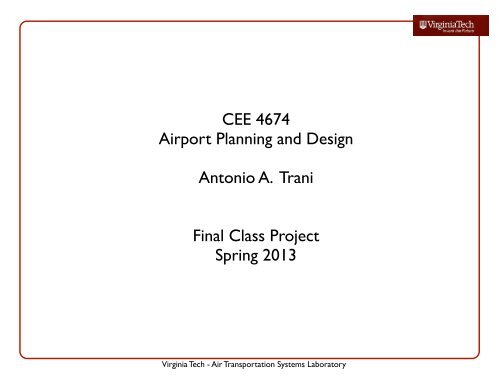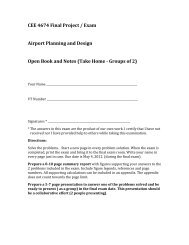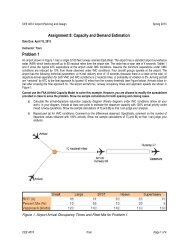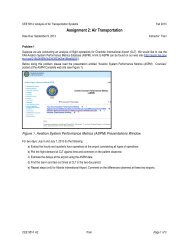CEE 4674 Airport Planning and Design Antonio A. Trani Final Class ...
CEE 4674 Airport Planning and Design Antonio A. Trani Final Class ...
CEE 4674 Airport Planning and Design Antonio A. Trani Final Class ...
Create successful ePaper yourself
Turn your PDF publications into a flip-book with our unique Google optimized e-Paper software.
<strong>CEE</strong> <strong>4674</strong><strong>Airport</strong> <strong>Planning</strong> <strong>and</strong> <strong>Design</strong><strong>Antonio</strong> A. <strong>Trani</strong><strong>Final</strong> <strong>Class</strong> ProjectSpring 2013Virginia Tech - Air Transportation Systems Laboratory
Problems to Address in <strong>Final</strong> Report• Problem # 1• Noise study of the Punta Cana Internationalairport (PUJ)• Problem # 2• Runway capacity at LAX airportVirginia Tech - Air Transportation Systems Laboratory2
Problem # 1 for <strong>Final</strong> ProjectNoise Study of PUJ <strong>Airport</strong>Virginia Tech - Air Transportation Systems Laboratory3
The Punta Cana <strong>Airport</strong> (PUJ)North (0 deg.)West (270 deg.)East (90 deg.)Runway 26South (180 deg.)Taxiway AlphaRunway 08Runway 27Runway 09Taxiway EchoTerminalssource: Google Earth 7Virginia Tech - Air Transportation Systems Laboratory4
Some Facts• Runway 08-26 is the primary runway• Runway 09-27 is seldom used (departure operationsoverfly populated areas to the SouthEast)• 98% of the time runway 08 is used for l<strong>and</strong>ings <strong>and</strong>departures (wind prevails from the Ocean or from theEast)Virginia Tech - Air Transportation Systems Laboratory5
Flight Paths In <strong>and</strong> Out of the <strong>Airport</strong>• 98% of the operations occur from the West (l<strong>and</strong>ingson Runway 08)NorthEastnm = nautical mileVirginia Tech - Air Transportation Systems Laboratory6
Night <strong>and</strong> Day Time CommercialOperations at PUJ• 38 daily takeoffs, <strong>and</strong> 39 daily l<strong>and</strong>ings• 4 night takeoffs <strong>and</strong> 3 night l<strong>and</strong>ingsVirginia Tech - Air Transportation Systems Laboratory7
General Aviation Night <strong>and</strong> DayOperations at Punta Cana• Total of 24 daily operations• 20 daytime <strong>and</strong> 4 night time• 10 daytime takeoffs <strong>and</strong> 10 daytime l<strong>and</strong>ings• 2 nighttime takeoffs <strong>and</strong> 2 nighttime l<strong>and</strong>ingsVirginia Tech - Air Transportation Systems Laboratory8
Flight Paths In <strong>and</strong> Out of the <strong>Airport</strong>• 98% of the operations occur from the West (l<strong>and</strong>ingson Runway 08)NorthEastnm = nautical mileVirginia Tech - Air Transportation Systems Laboratory9
Problem # 1• Create an INM case for Punta Cana following theinstructions of this h<strong>and</strong>out• Include all arrival <strong>and</strong> departure tracks shown on page 6•Add aircraft operations shown on pages 68 <strong>and</strong> 69 of thish<strong>and</strong>out using the following rules:• All ATR72 arrivals use Arrival Track 2••• All other arrivals use arrival track 110% of the arrivals by B737-800 use arrival track 230% of MD-80 arrivals use arrival track 2• All takeoffs use departure track 1 10Virginia Tech - Air Transportation Systems Laboratory
Problem # 1 (by Group) (2)• Create two helicopter routes as shown on page 4•Assign 3 helicopter arrivals <strong>and</strong> 3 departures daily to eachtrack created (can use P-tracks) - all daytime events• Model the Robinson R44 helicopters using the INM modelRobinson R44 RavenGo to SETUP --> Helicopters ...source: WikipediaVirginia Tech - Air Transportation Systems Laboratory11
Problem # 1 (by Group) (3)• Use the following stage lengths <strong>and</strong> INM profiles 12Data from PUJairport informationVirginia Tech - Air Transportation Systems Laboratory
For the Baseline Noise Analysis• 84 commercial operations daily• 24 GA <strong>and</strong> corporate aviations daily• 108 daily operations (on average day)• 54 arrivals• 54 departuresVirginia Tech - Air Transportation Systems Laboratory14
Night <strong>and</strong> Day Time CommercialOperations at PUJ• 38 daily takeoffs, <strong>and</strong> 39 daily l<strong>and</strong>ings• 4 night takeoffs <strong>and</strong> 3 night l<strong>and</strong>ingsVirginia Tech - Air Transportation Systems Laboratory15
General Aviation NIght <strong>and</strong> DayOperations at Punta Cana• Total of 24 daily operations• 20 daytime <strong>and</strong> 4 night time• 10 daytime takeoffs <strong>and</strong> 10 daytime l<strong>and</strong>ings• 2 nighttime takeoffs <strong>and</strong> 2 nighttime l<strong>and</strong>ingsVirginia Tech - Air Transportation Systems Laboratory16
Getting the INM Model• Go to the Syllabus Home page (http://128.173.204.63/courses/cee<strong>4674</strong>/syllabus_ce_<strong>4674</strong>.html)• Unzip the file <strong>and</strong> launch the setup application to install INM 7.0b• Works with Windows XP, Windows 7 <strong>and</strong> VistaTo get the FAA INM ModelVirginia Tech - Air Transportation Systems Laboratory17
Problem # 2Runway Capacity AnalysisLAX <strong>Airport</strong>Virginia Tech - Air Transportation Systems Laboratory18
LAX Runway Capacity Analysis• Table 1 illustrates the typical aircraft fleet mix operating at LAX<strong>Airport</strong> in the typical day• In the typical day at LAX (year 2011), the airport h<strong>and</strong>led 1,830operations. Half of them arrivals <strong>and</strong> the other half departures.Aircraft % Fleet Mix in 2011 Wake <strong>Class</strong>B737 (300-500) 9 LargeEmbraer 120 8 SmallB737 (600-900) 20 LargeB757 (200-300) 14 B757B747 (200-400) 7 HeavyB747-8/A380 3 Super-heavyDHC-8-400 6 LargeB767 (200-400) 5 HeavyA320 (318-321) 13 LargeCRJ (200-900) 5 LargeB777 (200-300) 10 HeavyTotals 100Virginia Tech - Air Transportation Systems Laboratory19
Typical Runway use at LAX <strong>Airport</strong>• West-flow operations at LAX <strong>Airport</strong>. Runways 24R<strong>and</strong> 25L used for arrivals. Runways 25R <strong>and</strong> 24Lused for departuresVirginia Tech - Air Transportation Systems Laboratory20
Typical IMC Separation Matrix Used atLAX <strong>Airport</strong>• Using the arrival-arrival <strong>and</strong> departure-departureseparation matrices shown in Tables 1 <strong>and</strong> 2, you willdetermine the VMC <strong>and</strong> IMC saturation capacity ofthe airport for West Flow operations.Table 1. IMC Separation Matrix.Virginia Tech - Air Transportation Systems Laboratory21
Typical IMC Departure-DepartureSeparation Matrix• Measured ROT values at the airport for 5 wakeclasses are: 52 (small), 55 (large), 54 (B757), 63(Heavy) <strong>and</strong> 78 (Superheavy) secondsTable 2. IMC Departure-Departure Separation Matrix.Virginia Tech - Air Transportation Systems Laboratory22
Technical Parameters• For both IFR <strong>and</strong> VFR conditions, the airport operatesarrivals on runways 24R <strong>and</strong> 25L• Departures are h<strong>and</strong>led on runways 24L <strong>and</strong> 25R•The approach speeds (in knots) derived from radar data are:127 (small), 138 (large), 145 (B757), 150 (Heavy) <strong>and</strong> 153(Superheavy)• The airport has the following technical parameters: a) in-traildelivery error of 13 seconds, b) departure-arrival separationfor both VMC <strong>and</strong> IMC conditions is 2 nautical miles, c)probability of violation is 5%. Arriving aircraft are “vectored”by ATC to the final approach fix located 8 miles from therunway threshold.Virginia Tech - Air Transportation Systems Laboratory23
LAX ChartVirginia Tech - Air Transportation Systems Laboratory24
Important Operational Practices at LAX• During IMC conditions• if an arrival to runway 24R is of type heavy or superheavy,these aircraft do not fit well in the holding area betweenrunways 24R <strong>and</strong> 24L on runway exits AA <strong>and</strong> BB• ATC cross heavy <strong>and</strong> superheavy aircraft immediately afterl<strong>and</strong>ing <strong>and</strong> restrict departures on runway 24L until the aircrafthas crossed the runway 24LRunway 24R!Taxiway AA!Runway 24L!Virginia Tech - Air Transportation Systems Laboratory25
Important Operational Practices at LAX• For all weather meteorological conditions• A heavy or superheavy aircraft arriving on runway 24R <strong>and</strong>taking exit AA (shown below) takes 45 seconds to travel thedistance shown in the diagram (in red) to clear runway 24L• During the crossing procedure departures on runway 24L arestopped until the heavy or superheavy aircraft has crossedthe active runway (24L)Runway 24R!Heavy <strong>and</strong>superheavycannot hold betweenrunways due to the limitedholding areaTaxiway AA!Runway 24L!Virginia Tech - Air Transportation Systems Laboratory26
Important Operational Practices at LAXNorth Runways!North!06L-24R!700 ft!06R-24L!Super heavy <strong>and</strong> most heavy !aircraft cannot hold !between runways (ATC crosses !them quickly)!LAX Procedures (today)!South Runways!07L-25L!07R-25L!800 ft!Center taxiway!South!Virginia Tech - Air Transportation Systems Laboratory27
Important Operational Practices at LAX• In VMC conditions• Arrivals to runway 24R are operated independentlyfrom departures on 24L• Arrivals to runway 25L are operated independentlyfrom departures on 25R• Assume that under VMC conditions:• The arrival-arrival separations employed are 85%of those under IMC conditions• Departure-departure separations are 90% of thoseemployed under IMC conditionsVirginia Tech - Air Transportation Systems Laboratory28
Relevant Analyses• Calculate the saturation runway capacity of theairport under IMC <strong>and</strong> VMC conditions• Plot the complete Pareto capacity diagram for VFRconditions at the airport. Label appropriately.• Estimate the benefit of using the natural gapsbetween successive arrivals on runways 24R <strong>and</strong>25L to accommodate a few more departures at theairport• Quantify the number of departures on 24R <strong>and</strong> 25Lmaintaining 100% arrival priority on 24R <strong>and</strong> 25L.Explain what are the possible drawbacks of allowingdepartures on the outer runways.Virginia Tech - Air Transportation Systems Laboratory29
<strong>Final</strong> Exam - Report for <strong>Class</strong>• Assemble a final report per groupshowcasing the following analyses:• Noise analysis (baseline dem<strong>and</strong>)• Runway capacity for the LAX airport with thefleet mix provided• Due May 11, 2013 according to VT final scheduleVirginia Tech - Air Transportation Systems Laboratory30
Things to Watch in Report• Page numbers (a must)• References (if any included)• Label figures <strong>and</strong> tables with numbers <strong>and</strong>captions• Appendices (if needed to support other work)Virginia Tech - Air Transportation Systems Laboratory31







